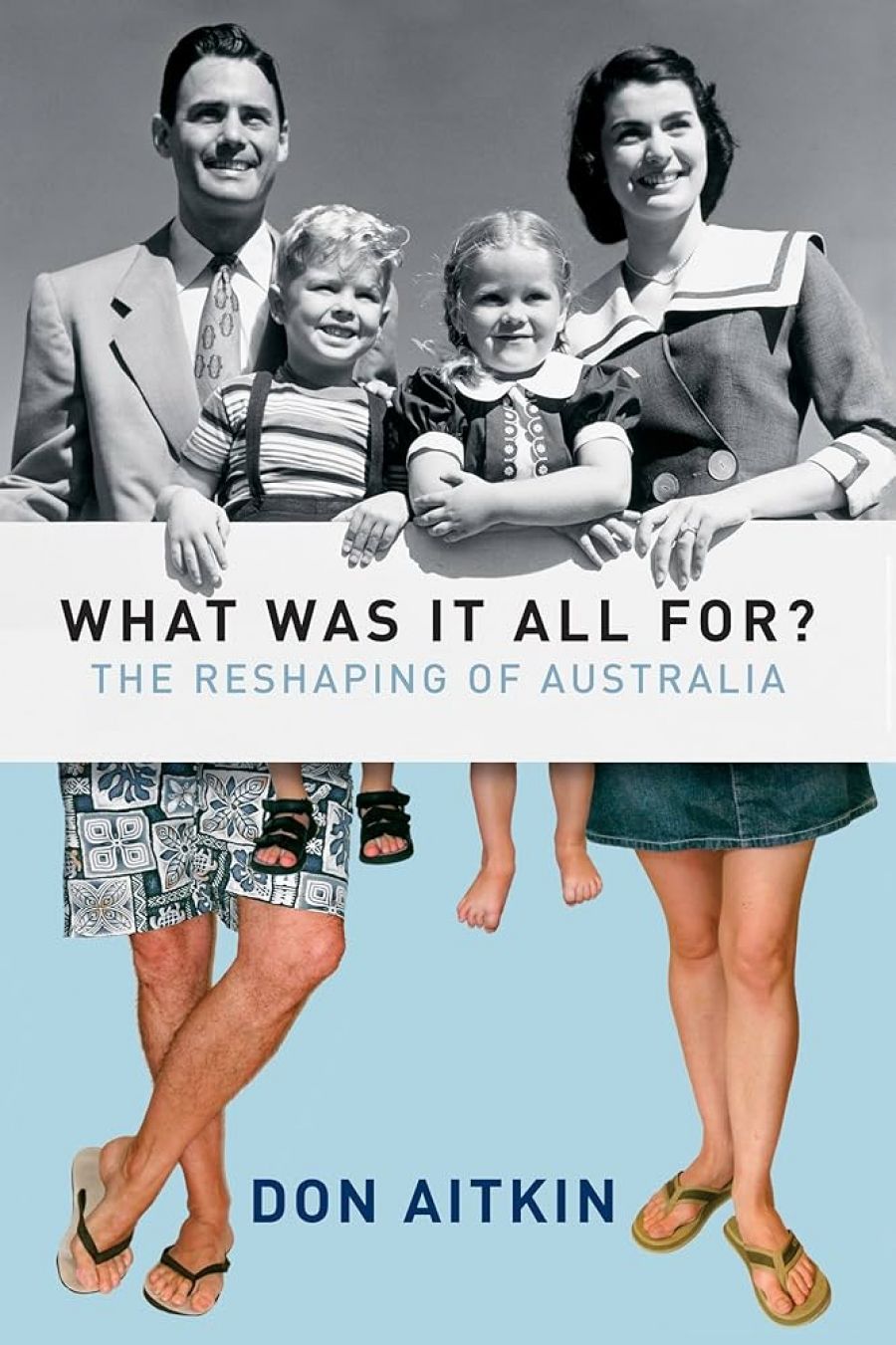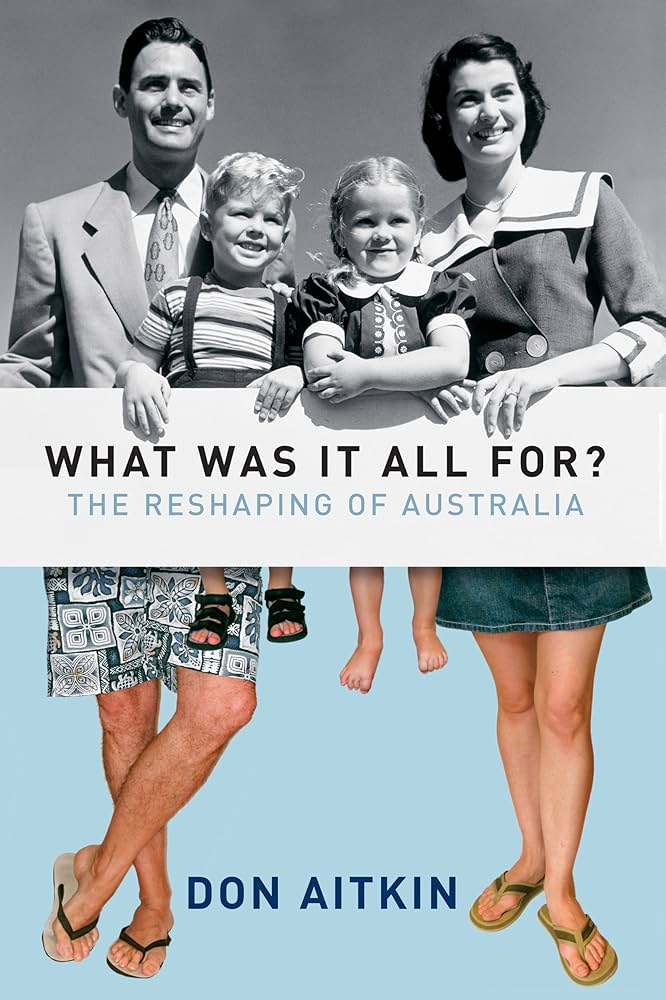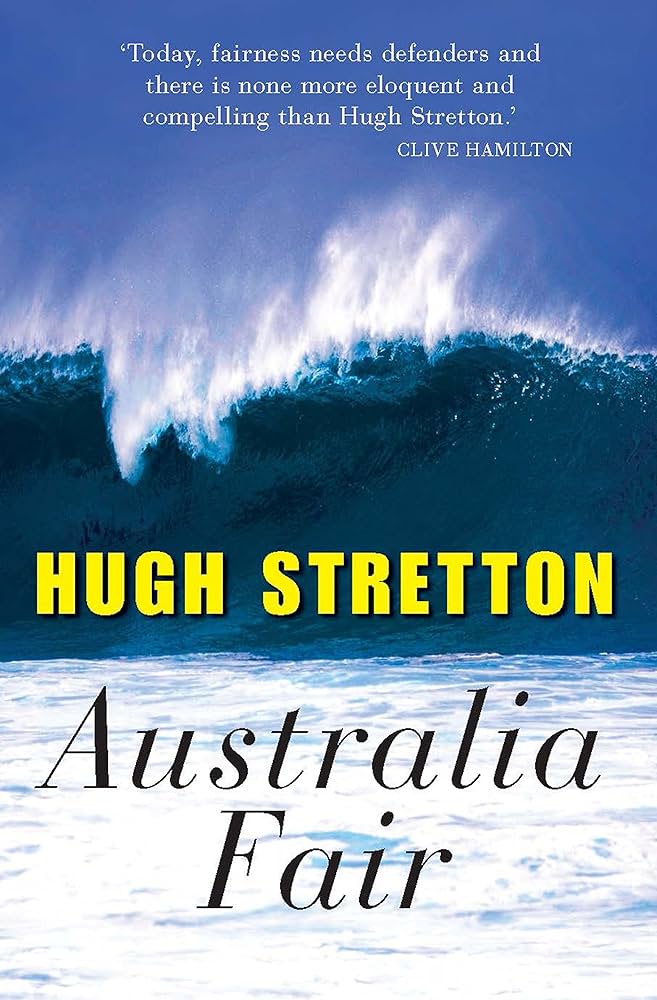
- Free Article: No
- Contents Category: Non-fiction
- Review Article: Yes
- Article Title: Australian dreams
- Online Only: No
- Custom Highlight Text:
Don Aitken was born in 1937, Hugh Stretton in 1924. They have both had distinguished academic careers, making important contributions to the development of Australian social science, and at various points have been prominent in public debate. Both of these books might be seen as reflections on the current state of Australia, about which the younger Aitken is clearly more optimistic than is Stretton.
- Book 1 Title: What Was It All For?
- Book 1 Subtitle: The reshaping of Australia
- Book 1 Biblio: Allen & Unwin, $24.95 pb, 286 pp
- Book 1 Cover Small (400 x 600):

- Book 1 Cover (800 x 1200):

- Book 2 Title: Australia Fair
- Book 2 Biblio: UNSW Press, $39.95 pb, 302 pp
- Book 2 Cover Small (400 x 600):

- Book 2 Cover (800 x 1200):

Stretton is a passionate social democrat who could easily be dismissed as old-fashioned and out of touch in his defence of the state’s role in promoting equality. I would not so dismiss him; social policies are not wrong because they have been suggested before, and Australia would benefit from a better understanding of how a number of European countries have adjusted to global economic shifts without necessarily jettisoning state welfare and equity programmes. Quite rightly, Stretton is appalled by evidence of growing inequality at a time when the country is increasingly wealthy, and wants to rectify this. One of the most valuable parts of the book is the careful discussion of the various claims and counter-claims about growing inequality in contemporary Australia.
Thus Stretton expects more from the Labor Party than he believes is offered by its current leadership: ‘In 2005 most people … expect Labor to lose the 2007 election. So why not lose it with an up-to-date program of full employment and other blessings?’ In response, Labor could well point out that Stretton isn’t very interested in their current thinking; in recent years, frontbenchers Wayne Swan and Lindsay Tanner (and influential backbencher Craig Emerson) have all published substantially on their views of economic management. Anyone making the case Stretton wants to make has an obligation to read them seriously.
Australia Fair is a well-intentioned book, but it does not add much to Stretton’s previous books. To do so he would need to be far more insightful about the Howard government’s ability to win over many people who, ostensibly, would be better off under a Labor government. Stretton is aware of the costs of privatisation, but, oddly, he ignores some of the most flagrant examples, such as the decline of public transport in Melbourne after it was sold off by the Kennett government, or the use of private companies to run basic facilities such as prisons and immigration detention centres.
My real problem with Stretton’s book is that, while he wants Labor to be bold and imaginative, this is, in practice, a very timid book, which, in Nancy Fraser’s terms, deals with the inequalities of distribution better than it does with those of recognition. There’s a refreshing candour to Stretton’s admission that some of the issues facing indigenous Australians ‘seem intractable’, but a book of 300 pages that seeks to make Australia a fairer society needs to go beyond this.
Don Aitken attended Armadale High School in the 1950s, and has chosen to frame his account of how Australia has changed in the past half century by reference to his former classmates. This is a clever conceit, and the book comes to life when we hear the voices of real people. They were more mixed in class origin than one might imagine, though almost exclusively British and Protestant in background; of those he interviewed three never married, but Aitken is too discreet – or incurious – to speculate about their sexuality.
Aitken sees Australia as far more individualistic and diverse than it was fifty years ago, and, on balance, he seems to welcome the change. His informants are less sure: as Aitken reports, they believe that ‘something has plainly happened to the notion of “community”’. Probably correctly, Aitken points out that we do not know enough about ‘trust’ and ‘compassion’ to be sure that they have declined over time. One might point out that he ignores the question of our treatment of asylum seekers, which might make him less sanguine about Australian attitudes than he appears. (He does deal well with the changing realities of crime and drug use, neither of which seems to interest Stretton.)
In Aitken’s view, the shifts in Australian culture are the result of education, wealth and immigration, of which he sees the first as most important. This is perhaps not surprising, given that he has spent his entire life within the education system, but his emphasis on the importance of education in promoting equal outcomes – and his rejection of genetic explanations for different levels of ability and achievement – is an important corrective to the half-baked social Darwinism that is increasingly invoked to defend disparities of wealth. But too often this book strings together well-known facts and (lesser-known) statistics, so that it reads like a textbook masquerading as an essay. He gives us lots of data to support his view that creativity is flourishing in Australia, but specific references to films or novels, which might have made the point, are missing. On the other hand, his own role in the very beginning of Peter Allen’s musical career is told with an appropriate mix of modesty and awe: even those who rise to become vice-chancellors can still be impressed by the boy from Tenterfield who conquered Broadway.
Both Stretton and Aitken are socially quite conservative: Stretton has consistently defended suburbia as the great Australian dream, and Aitken, while attacking those who believe in genetic differences in intelligence, subscribes to a fundamental difference between men and women based upon ‘different brain architecture’. Both can claim that they, not John Howard, are conservative in wishing to maintain a more egalitarian and compassionate society than the one the current government is creating.
The biggest problem with the sort of radical conservatism that pervades these books and currently characterises a great deal of the responses to major policy shifts is that it still works within an entirely national framework, even though both are willing to invoke other countries – Canada and Norway – as possible alternate models for Australia to emulate. Neither Stretton nor Aitken pays much attention to the ways in which globalisation, as both an economic and cultural force, is reshaping the very idea of what is and is not controlled at a national level; neither of them has anything to say, except in passing, about our relations with countries such as Indonesia and China.
Yet when we reflect on 2005, two events might stand out: the outpouring of support for the victims of the tsunami of December 2004, and the bitter divisions around the hanging of Australian heroin smuggler Nguyen Tuong Van in Singapore one year later. Both events showed that, despite the early rhetoric of the Howard government against Paul Keating’s stress on Asia, there has been a major shift in Australian attitudes: these two events bookmark ongoing concern with terrorism in Bali, earthquakes in Kashmir and trade with China, all of which are signs of a slow but inexorable move to reimagining Australia as a real part of its region.
This shift is ignored by Stretton and is almost invisible to Aitken (who does, at least, acknowledge the impact of the tsunami). Having spent much of the year in the US, I am struck by the weight of geography: Kuta, Singapore, Phuket and, increasingly, Shanghai and Mumbai are familiar to Australians in ways that they are not to those who live in the North Atlantic world. More important, increasing numbers of Australians, born both here and overseas, move between countries with an ease that suggests that we can no longer think of our future as bounded by national frontiers.
Australia Fair and What Was It All For? are old-fashioned books in that they write about Australia as if we largely existed in a vacuum rather than seeing Australia as inextricably and increasingly enmeshed in an extraordinarily complex range of economic, social, cultural and political ties with the larger world. We often discuss the ways in which constant migration means that the nature of Australia is changing, although this doesn’t seem of great concern to Stretton. What we haven’t fully appreciated is how we are also changing as more and more Australians spend time overseas, as workers, students, soldiers, consultants and tourists; and how this reflects the larger reality that globalisation is weakening national divisions even as governments seek to expand their control over frontiers.
The real question these books posed for me is how can Australia be a fair and egalitarian society in a world so starkly divided between the beneficiaries and the losers of globalisation. Unfortunately, that’s not a question that seems to have occurred to either author.


Comments powered by CComment